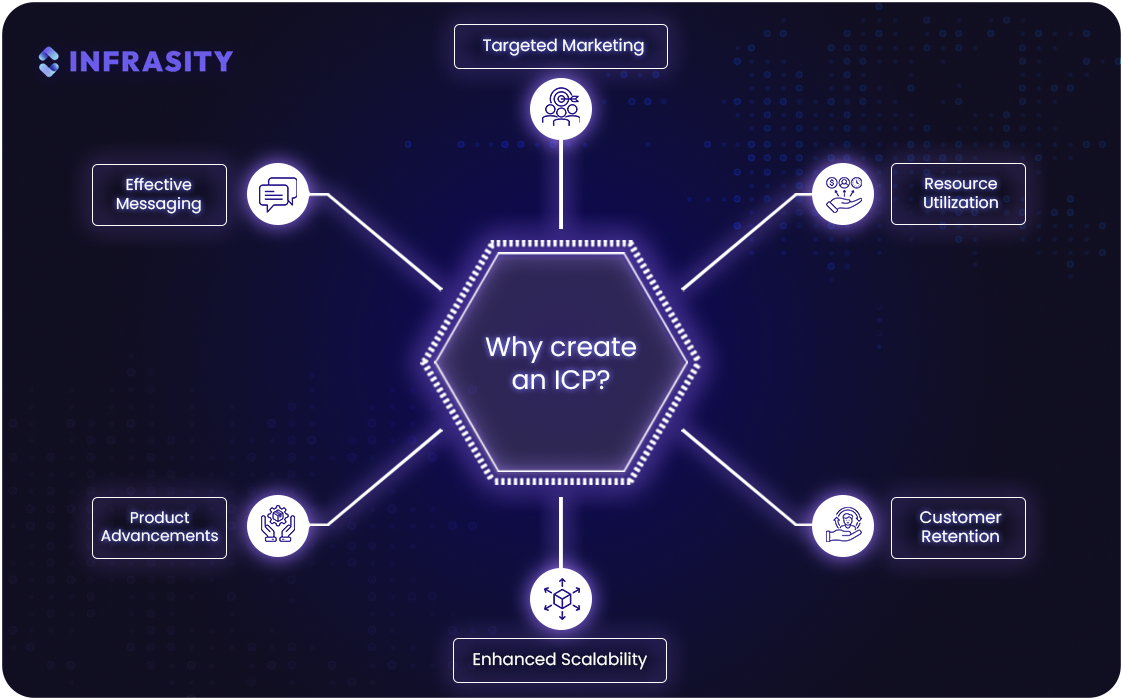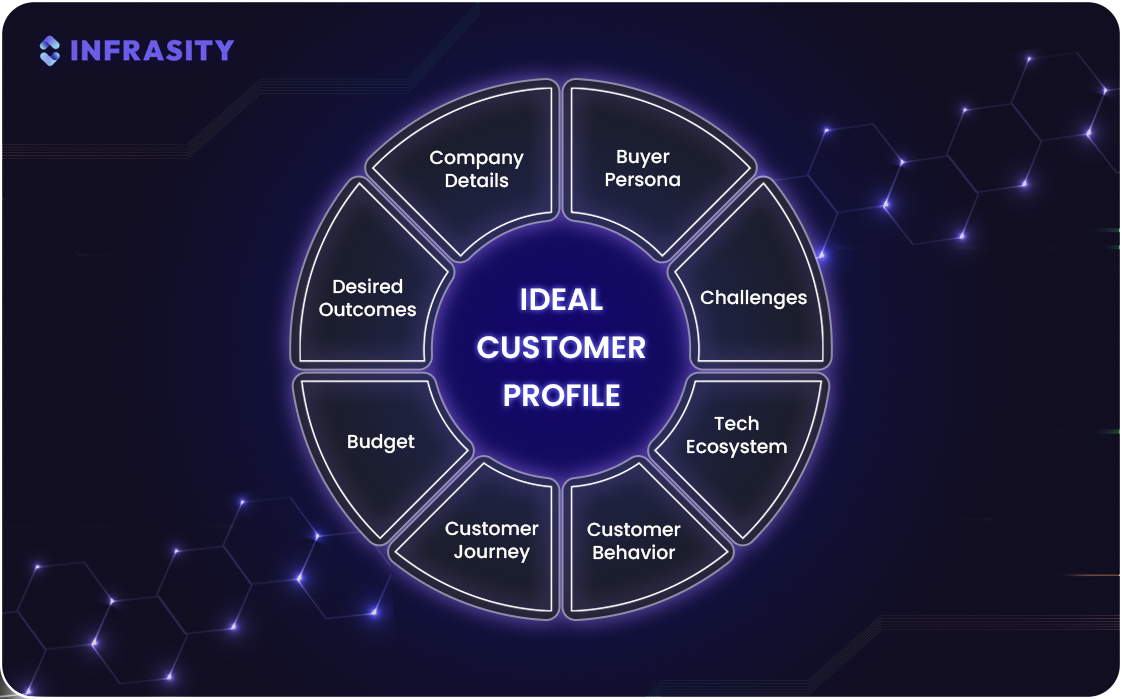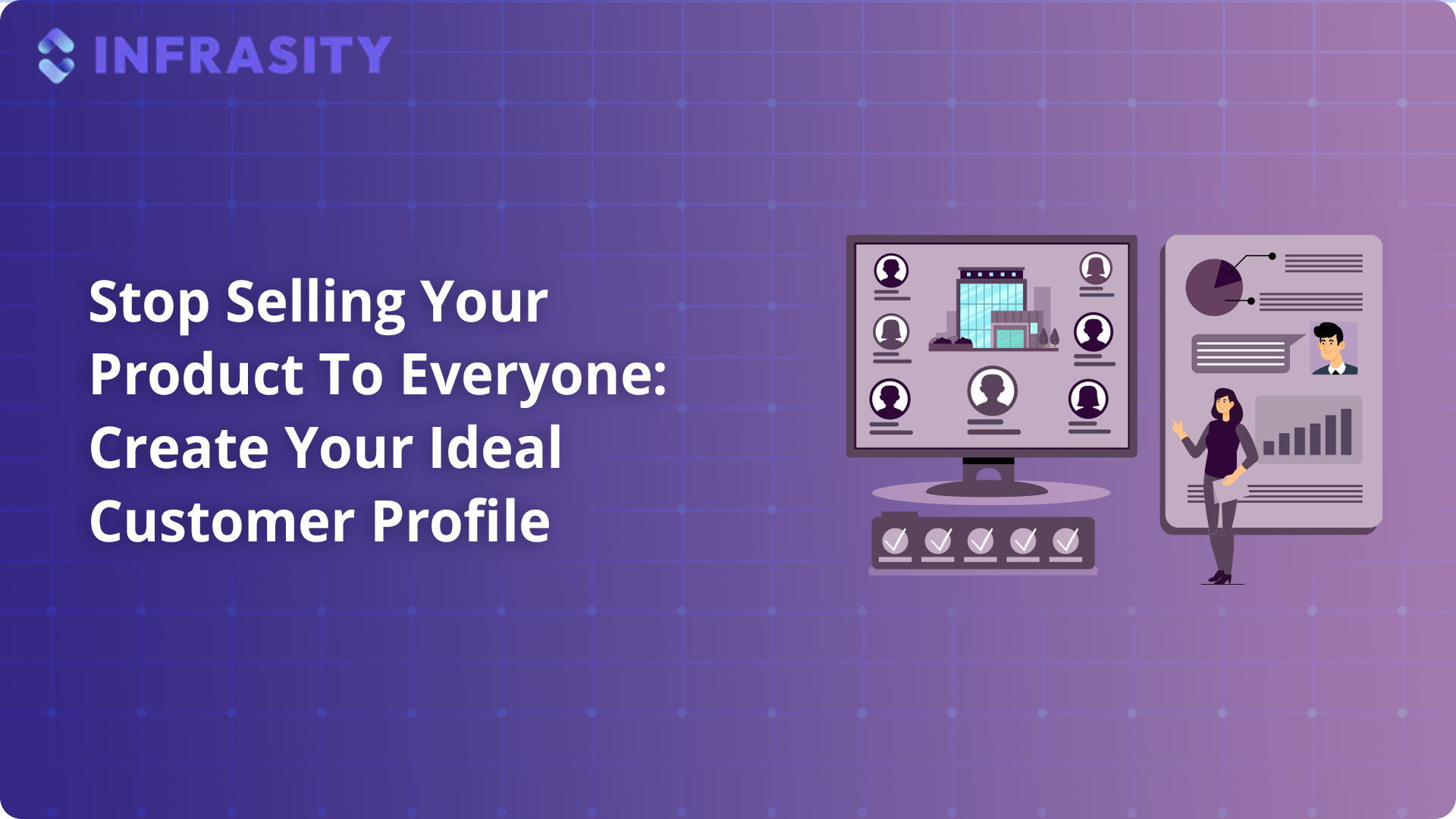Introduction
What's the point of investing so much time, energy, and budget into marketing if it ends up reaching a broad audience - some who need your product and many who never will?
Your message reaches a mixed crowd: a few ideal users, and a whole lot of people who'll never convert. The result? Confused leads, wasted spending, and a growth graph stuck in neutral.
If you're a B2B SaaS startup, every dollar counts. So before you write another blog post, run another ad, or redesign your homepage for the fifth time - Pause. The issue may not be with your marketing methods.
It might actually be that you are unclear on who you are selling to. And that's where a solid Ideal Customer Profile (ICP) comes into play - your guiding star for marketing, sales, and even product decisions. In this article, I'll explain what an ICP is, why it is important, what it should consist of, and how leading SaaS companies have utilized it to grow effectively.
Let's start with the basics.
What is an ICP?
An Ideal Customer Profile (ICP) is a detailed description of the type of company that's most likely to buy your SaaS product and stick around because they actually need it.

It's not just about who could use your product; it's about who gets the most value from it. These are the companies with the right size, stage, challenges, and workflows where your solution fits in naturally and delivers real value.
Think of it like this: if your sales team had a list of dream customers who "just get it" on the first call, those are your ICPs. They're already facing the exact problems your product solves, they're actively searching for solutions, and they have the resources to buy and implement.
A strong ICP helps you stop chasing anyone and everyone. Instead, it guides your marketing, sales, and product decisions toward the companies where you have the highest chance of winning and keeping business.
Tired of wasting engineering time on content?
Why Create an Ideal Customer Profile?
Creating an ideal customer profile is just as important as developing a great product. Here's why:

1. Targeted Marketing
A well-prepared ideal customer profile gives you the opportunity to efficaciously utilize your marketing efforts. It helps you target the right set of audiences, leading to a higher possibility of conversion.
You understand the characteristics of your target audience, creating hyper-focused marketing campaigns to mitigate wastage of financial resources, boost return on investment (ROI), and increase conversion rates.
2. Effective Messaging
An ICP provides the opportunity to develop messages that resonate with the needs and interests of the target audience - it's as if your messages speak to your prospects directly.
By incorporating these audience-focused messages into your content, ad copy, and sales pitches, you help your audience feel that you understand their pain points - and have developed your SaaS product to solve them.
3. Resource Utilization
A clear ICP aids in utilizing resources efficiently, allowing you to focus your marketing and sales efforts on high-potential leads. It eliminates the wastage of time and money on low-value potential customers.
Additionally, it helps you allocate budget based on which target audience will drive maximum conversions at a lower cost and time investment.
4. Product Advancements
When you understand the needs and pain points of your ideal customers, you can make data-driven product developments. Identifying the required features and updates in your SaaS product through ICP insights helps developers focus their effort and skills in the right areas.
This reduces development costs, ensures limited resources are used appropriately, and ultimately increases product adoption and customer satisfaction.
5. Customer Retention
As you develop the SaaS product based on your ICP’s pain points and interests, it improves customer satisfaction and lifetime value. It also increases the likelihood of customers turning into loyal advocates and decreases churn rates.
6. Enhanced Scalability
Your ideal customers have common characteristics and behavior patterns. Creating an ICP helps you identify these patterns, allowing you to understand how they interact with your sales and marketing campaigns.
This insight guides you in recognizing which aspects of your strategy are working, and helps you develop standardized workflows for business growth and scalability.
What Should Your Ideal Customer Profile Look Like?
There's a lot to consider when defining your Ideal Customer Profile (ICP), but let's break it down with an example to understand better. Suppose you've developed a Data Analytics Platform that helps companies manage and utilize their data to make data-based decisions.
Now, let's understand the key elements your ICP should include:

1. Company Details
Identify the type of companies that would get the most value from your solution. Consider the following factors:
- Size: Mid-market to enterprise companies with 100–1000+ employees
- Industry: Sectors like retail, finance, healthcare, or any industry heavily dependent on data
- Location: Regions where these prospects would be based - Texas, New York, Europe, etc.
2. Buyer Persona
It's important to determine which customer personas you need to target. Identify the key roles in the company that will be involved in the buying process and understand what matters to them.
For a data analytics platform, here are the typical personas to consider:
- The User - Usually a Data Analyst or Business Intelligence professional who will use the platform daily. They care about intuitive dashboards, quick insights, and smooth workflows.
- The Manager - Likely to be a Head of Analytics or Department Lead who wants to boost team productivity and ensure efficient reporting. They evaluate tools based on team needs, performance, and results.
- The Decision-Maker - Typically a CTO, CIO, or Director of Operations. Their focus is on business alignment, data security, budget justification, and ROI.
3. Challenges
Outline the pain points of your ideal customers so you can create a marketing strategy that resonates with their needs. Some of the challenges your potential clients might face include:
- Data Overload: Companies are often overwhelmed by massive amounts of unstructured or poorly managed data.
- Slow Decision-Making: Teams can't make data-driven decisions fast enough because their current tools are too slow or inefficient.
- Inefficient Reporting: They need real-time insights, but their existing systems are not providing accurate, up-to-date reports.
- Lack of Predictive Insights: Companies struggle to predict trends or customer behavior because they lack advanced analytics capabilities.
4. Tech Ecosystem
Understand the tech environment of your prospects - which tools and software they are using. This will help you identify how you can pitch your SaaS product and provide seamless integration into their workflow.
For example:
- They might be using Business Intelligence (BI) tools like Tableau, Power BI, or Excel but may need more advanced functionality like predictive analytics.
- They could be using cloud platforms such as AWS, Google Cloud, or Azure.
- They might also rely on CRMs like Salesforce or marketing automation tools like HubSpot.
5. Customer Behavior
Determining your ideal customer's buying preferences, communication methods, and values is a key part of developing a data-driven strategy to capture and retain their attention.
- Buying Habits: Companies needing a Data Analytics Platform are typically solution-oriented. They conduct plenty of research, request demos, and seek case studies or proof of ROI before making a purchase.
- Communication Styles: Decision-makers often prefer detailed product demos, white papers, and use cases.
- Values: Potential customers prioritize data accuracy, productivity, and making faster data-driven decisions than their competitors.
6. Customer Journey
Understanding the customer journey helps you optimize your sales process. Here's how your ideal customer typically progresses:
Awareness:
Data leaders (e.g., Chief Data Officers, BI heads) recognize inefficiencies in their current BI setup, such as limited forecasting, delayed reporting, or siloed insights.Consideration:
Tech and analytics teams begin evaluating platforms that support predictive modeling, real-time dashboards, and seamless integration with tools like AWS, Salesforce, or existing data lakes.Decision:
CTOs and procurement teams assess platform scalability, security (e.g., GDPR/CCPA compliance), deployment models (cloud/on-premise), and potential ROI across departments.Onboarding:
Data engineers and IT teams handle integration with current infrastructure; analysts receive role-based training to operationalize insights.Adoption:
BI teams automate dashboards, department heads start data-driven planning, and marketing/operations teams begin real-time campaign and performance tracking.Expansion:
Seeing measurable impact, more business units (like finance, HR, or logistics) get onboarded, and custom analytics modules are implemented to scale decision intelligence.
7. Budget
Ensure that you are targeting companies that have sufficient and dedicated budgets for data analytics tools. It will have a low conversion value if your target company doesn't have the financial resources to buy your product.
8. Desired Outcomes
Identify the desired outcomes of your prospects. Then, showcase your product in a way that denotes your SaaS product is the solution to achieving their goals. Desired outcomes could include:
- Improved Decision-Making: They want to use real-time, data-driven insights to make better business decisions.
- Operational Efficiency: They need a platform that helps in streamlining reporting, reduces manual effort, and enables faster insights.
- Scalable Data Solutions: As the company grows, it needs a solution that can scale with its increasing data needs.
By clearly defining these key elements of your Ideal Customer Profile, you make sure that your marketing, sales, and product strategies are aligned with your goals.
ICP Examples of B2B SaaS Companies
Now that you have a clear idea of how to create an ideal customer profile, let us take a look at some B2B SaaS companies that gained a significant number of customers.
1. Asana
Asana's journey shows how startups can successfully expand their ICP as they scale from nimble SMBs to complex enterprise teams.
Asana released its project management and team collaboration platform to the market in 2008 for the purpose of helping businesses optimize their work organization and tracking systems. Asana started by targeting remote or distributed small and medium-sized businesses but now caters to organizations across all markets ranging from mid-market to enterprise clients.
Ideal Customer Profile (ICP) Highlights:
- Company Size: SMBs (50–500 employees), Mid-Market (500–1000), and Enterprises (1000+ employees)
- Core Need: Improve teamwork, task management, transparency, and operational efficiency across teams and departments
Buying Behavior:
- SMBs prefer self-service signups via the free trial or freemium model
- Enterprises require advanced security, custom workflows, and governance controls
Some ICP Industry Segments and Customers:
- Technology: Zoom, Spotify, Figma, Quora
- Media: Vox Media, Gannett, Discovery Digital Studios
- Retail: Christian Dior, Stride, Barfoot & Thompson
- Government: Manchester City Council, City of Providence
- Education: University of Melbourne, Blackboard, Telfer School of Management
- Fintech: loanDepot, Morningstar, TDM Growth Partners
How ICP Clarity Helped Asana Scale:
By deeply evaluating the evolving needs of its target customers, Asana was able to align its product roadmap and marketing messaging - from self-serve onboarding for SMBs to compliance-driven enterprise deployments. Publishing case studies from successful customers across industries and offering a free trial lowered the adoption barrier, fueling Asana's global growth.
2. Gong
Gong's journey shows how a startup can achieve explosive growth by staying obsessively focused on a narrow, high-fit ICP from day one.
Founded in 2015, Gong is a revenue intelligence platform that helps sales teams capture, analyze, and improve customer interactions. From the very beginning, Gong focused tightly on mid-sized B2B SaaS companies, specifically sales organizations that were large enough to face visibility problems but agile enough to adopt new tools quickly.
Ideal Customer Profile (ICP) Highlights:
- Company Size: Mid-market companies, typically 50–500 employees in the sales team
- Core Need: Gain visibility into sales conversations, improve rep performance, and accurately forecast deals
Buying Behavior:
- VPs of Sales and Revenue Leaders looking for real-time coaching and pipeline insights
- Teams already using video conferencing for sales calls (Zoom, Webex)
Gong's First ICP Criteria:
- Industry: B2B Software and SaaS companies
- Region: North America
- Sales Model: Inside sales or hybrid (remote) sales teams
- Deal Size: Average ticket size between $1,000 to $100,000
- Language: English-speaking sales teams
How ICP Clarity Helped Gong Scale:
By defining a sharp and specific ICP early, Gong avoided the common startup trap of trying to serve everyone. Instead, they built their Minimum Viable Product (MVP) alongside 12 handpicked design partners (early adopters). These were sales teams that matched their ICP and helped refine the product based on real-world usage and feedback.
Gong's team focused marketing and sales messaging directly on sales leaders' pain points, emphasizing better visibility into calls, faster coaching cycles, and stronger forecasting accuracy. They didn't initially lead with "AI"; instead, they framed the product as a sales efficiency tool, aligning exactly with what their ICP cared about.
Every devtool startup needs content. Most do it wrong.
Conclusion
Creating an ideal customer profile is a necessity for every B2B SaaS startup to market their product to the right audience. Once you crack the code and identify the right set of audiences who are seeking a solution to the challenges that your product can solve, it will help you position it better.
It has some key elements that you should consider — company details, buyer persona, challenges, tech environment, budget, success goals, customer journey, and behavior. Once you have created a strong ideal customer profile, you can leverage it in your marketing strategy, especially content marketing strategy.
We understand that hiring a content marketing team can go out of your budget at the early stage of your startup. Therefore, Infrasity's expert team of writers, designers, and developers ensures delivering high-quality content to B2B SaaS startups. We also help identify your ideal customer profile, so every content marketing effort and dollar counts.
FAQs
1. Can I Have More Than One Ideal Customer Profile?
Yes, as your company grows, it's normal to have multiple ICPs to target different customer segments. Just make sure each ICP is clearly defined so your messaging and product positioning stay sharp for each audience.
2. What Is the Difference Between an Ideal Customer Profile (ICP) and a Buyer Persona?
An ideal customer profile defines the type of company that will benefit from your SaaS product, while a buyer persona defines the users, managers, and decision-makers inside that company.
3. What Is an ICP Score?
An ICP score is a metric that helps determine how well a prospect matches a company's ideal buyer profile. It is calculated using parameters such as company size, industry, and customer behavior.
A good ICP score ensures the company's sales and marketing efforts are focused on high-quality target customers.
4. What Are the Common Mistakes While Creating an ICP?
Common mistakes include targeting too broadly, relying on assumptions instead of real data, ignoring customer feedback, overlooking key demographics and competitor insights, and failing to update the profile regularly.
5. What Information Should Be Included in an Ideal Customer Profile?
Key details like company size, industry, budget, location, business challenges, goals, and purchasing behavior should be included.


